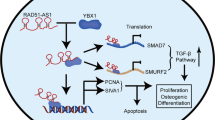Abstract
This study intended to clarify the mechanism of long noncoding RNA ZBTB40-IT1 in directing human bone marrow-derived mesenchymal stromal cell (hBMSC) differentiation. hBMSCs underwent osteogenic and adipogenic induction, and an osteoporosis mouse model was established via ovariectomy (OVX). Gain- and loss-of-function approaches were utilized in hBMSCs and mice to investigate the function of ZBTB40-IT1, microRNA (miR)-514a-3p, and forkhead box O4 (FOXO4). Dual-luciferase reporter and RNA pulldown assays were applied to evaluate the binding of miR-514a-3p to ZBTB40-IT1 or FOXO4. The femur of the OVX mice had upregulated ZBTB40-IT1 and FOXO4 expression and downregulated miR-514a-3p expression. The bone mass was increased in OVX mice through ZBTB40-IT1 or FOXO4 knockdown. ZBTB40-IT1 and FOXO4 were downregulated, whereas miR-514a-3p was upregulated in osteogenesis-induced hBMSCs, which was the opposite in adipogenesis-induced hBMSCs. ZBTB40-IT1 or FOXO4 knockdown or miR-514a-3p overexpression increased ARS/ALP absorbance and RUNX2 and OCN levels but decreased fat density and PPARγ and FABP4 levels in hBMSCs. Mechanistically, ZBTB40-IT1 elevated FOXO4 expression by binding to miR-514a-3p. miR-514a-3p inhibition annulled the effects of ZBTB40-IT1 downregulation on hBMSC osteogenesis and adipogenesis, and FOXO4 overexpression abolished the impacts of miR-514a-3p upregulation on hBMSC osteogenesis and adipogenesis. Conclusively, ZBTB40-IT1 inhibition promotes the osteogenic differentiation of hBMSCs via the miR-514a-3p/FOXO4 axis, thereby increasing bone mass.








Similar content being viewed by others
References
Sozen T, Ozisik L, Basaran NC. An overview and management of osteoporosis. Eur J Rheumatol. 2017;4:46–56.
Akkawi I, Zmerly H. Osteoporosis: current concepts. Joints. 2018;6:122–7.
Ensrud KE, Crandall CJ. Osteoporosis. Ann Intern Med. 2017;167:ITC17–32.
Hernlund E, Svedbom A, Ivergard M, et al. Osteoporosis in the European Union: medical management, epidemiology and economic burden. A report prepared in collaboration with the international osteoporosis foundation (IOF) and the European federation of pharmaceutical industry associations (EFPIA). Arch Osteoporos. 2013;8:136.
Khosla S, Hofbauer LC. Osteoporosis treatment: recent developments and ongoing challenges. Lancet Diabetes Endocrinol. 2017;5:898–907.
Kimbrel EA, Lanza R. Current status of pluripotent stem cells: moving the first therapies to the clinic. Nat Rev Drug Discov. 2015;14:681–92.
Wang C, Meng H, Wang X, Zhao C, Peng J, Wang Y. Differentiation of bone marrow mesenchymal stem cells in osteoblasts and adipocytes and its role in treatment of osteoporosis. Med Sci Monit. 2016;22:226–33.
Giuliani N, Lisignoli G, Magnani M, et al. New insights into osteogenic and chondrogenic differentiation of human bone marrow mesenchymal stem cells and their potential clinical applications for bone regeneration in pediatric orthopaedics. Stem Cells Int. 2013;2013: 312501.
Wan Y, Zhuo N, Li Y, Zhao W, Jiang D. Autophagy promotes osteogenic differentiation of human bone marrow mesenchymal stem cell derived from osteoporotic vertebrae. Biochem Biophys Res Commun. 2017;488:46–52.
Mei B, Wang Y, Ye W, et al. LncRNA ZBTB40-IT1 modulated by osteoporosis GWAS risk SNPs suppresses osteogenesis. Hum Genet. 2019;138:151–66.
Paraskevopoulou MD, Hatzigeorgiou AG. Analyzing MiRNA-LncRNA interactions. Methods Mol Biol. 2016;1402:271–86.
Stark MS, Bonazzi VF, Boyle GM, et al. miR-514a regulates the tumour suppressor NF1 and modulates BRAFi sensitivity in melanoma. Oncotarget. 2015;6:17753–63.
Chen D, Gong Y, Xu L, Zhou M, Li J, Song J. Bidirectional regulation of osteogenic differentiation by the FOXO subfamily of Forkhead transcription factors in mammalian MSCs. Cell Prolif. 2019;52: e12540.
Peng H, Mu P, Li H, et al. Caveolin-1 Is essential for the improvement of insulin sensitivity through AKT activation during glargine treatment on diabetic mice. J Diabetes Res. 2021;2021:9943344.
Zhao N, Wang Z, Cui X, et al. In vivo inhibition of MicroRNA-326 in a NOD.H-2(h4) mouse model of autoimmune thyroiditis. Front Immunol. 2021;12:620916.
Oden A, McCloskey EV, Kanis JA, Harvey NC, Johansson H. Burden of high fracture probability worldwide: secular increases 2010–2040. Osteoporos Int. 2015;26:2243–8.
Kanis JA. Diagnosis of osteoporosis and assessment of fracture risk. Lancet. 2002;359:1929–36.
Khosla S, Cauley JA, Compston J, et al. Addressing the crisis in the treatment of osteoporosis: a path forward. J Bone Miner Res. 2017;32:424–30.
Komori T. Regulation of proliferation, differentiation and functions of osteoblasts by Runx2. Int J Mol Sci. 2019;20:1694.
Zoch ML, Clemens TL, Riddle RC. New insights into the biology of osteocalcin. Bone. 2016;82:42–9.
Tontonoz P, Spiegelman BM. Fat and beyond: the diverse biology of PPARgamma. Annu Rev Biochem. 2008;77:289–312.
Floresta G, Pistara V, Amata E, et al. Adipocyte fatty acid binding protein 4 (FABP4) inhibitors. A comprehensive systematic review. Eur J Med Chem. 2017;138:854–73.
Acknowledgements
Thanks for all the contributors and participants.
Author information
Authors and Affiliations
Contributions
ZS: conceived the ideas. ZS: designed the experiments. QZ: performed the experiments. QZ: analyzed the data. YC and XL: provided critical materials. YC and XL: wrote the manuscript. ZS: supervised the study. All the authors have read and approved the final version for publication.
Corresponding author
Ethics declarations
Conflict of interest
The authors report no relationships that could be construed as a conflict of interest.
Ethical approval
All patients signed an informed consent form, and the experimental design was approved by the Ethics Committee of Nanfang Hospital, Southern Medical University (approval number: NFYY-2019-0541). All animal care, treatment, and surgical techniques followed the protocols approved by the Animal Care and Use Committee of Nanfang Hospital, Southern Medical University. Mice were used for this study under the “Implementation Rules for the Management of Medical Laboratory Animals” promulgated by the Chinese Health and Planning Commission and the “Guidelines for the Use and Management of Laboratory Animals” by the National Institutes of Health.
Additional information
Publisher's Note
Springer Nature remains neutral with regard to jurisdictional claims in published maps and institutional affiliations.
Rights and permissions
About this article
Cite this article
Shi, Z., Zhong, Q., Chen, Y. et al. Long noncoding RNA ZBTB40-IT1 regulates bone mass by directing the differentiation of human bone marrow mesenchymal stromal cells via the microRNA-514a-3p/FOXO4 axis. Human Cell 35, 1408–1423 (2022). https://doi.org/10.1007/s13577-022-00730-4
Received:
Accepted:
Published:
Issue Date:
DOI: https://doi.org/10.1007/s13577-022-00730-4




